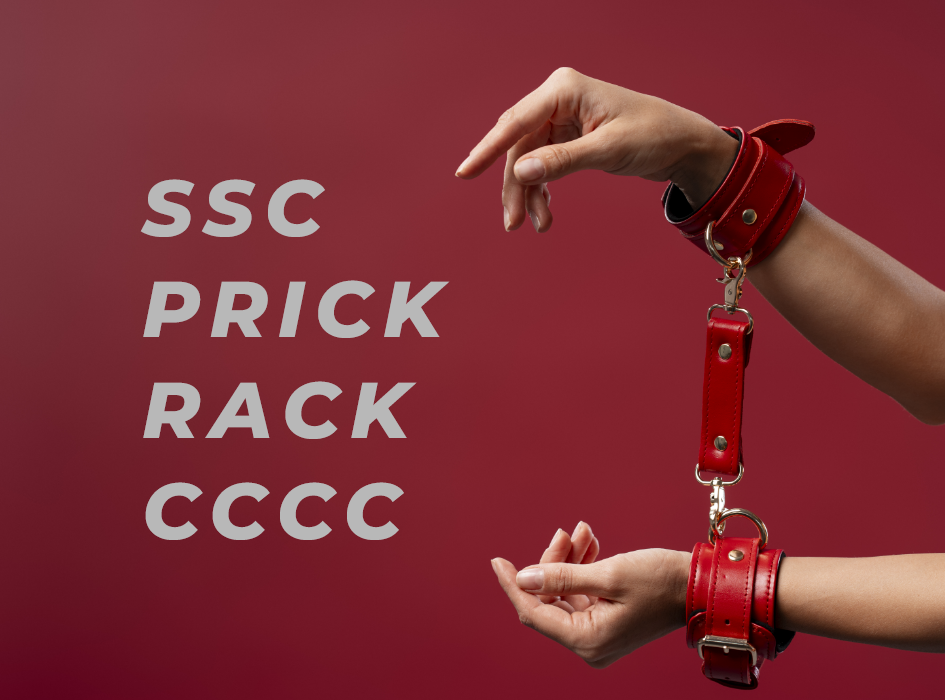Knife Play 101: A Beginner’s Guide to Safe and Sensual Knife Play
If you're exploring the exciting world of BDSM, you might have heard of knife play. The idea of using a knife in a scene can sound intense and maybe a little scary, but for people who are into it, knife play can bring a lot of thrill and excitement. It’s important to know, though, that knife play isn't about hurting your partner—it’s more about the sensations and emotions that the presence of a knife can bring. This guide is going to help you understand knife play in simple terms and give you tips on how to do it safely and enjoyably.
What is Knife Play?
Knife play is a type of BDSM activity where a knife is used to tease or create different sensations on the skin. For some people, the idea of sharp objects creates a mix of fear and excitement, making the experience much more intense. It’s a form of edge play, which means it's a bit riskier than other types of BDSM, so it needs to be done carefully.
During a knife play scene, the blade can be used in many different ways to tease, control, or heighten sensations. Here are a few common things people do during knife play:
- Cutting off clothing or ropes: The knife can be used to cut off your partner’s clothes or any bondage ropes, which creates a feeling of vulnerability.
- Teasing or subduing your partner: Gently running the blade over your partner's skin can tease them and build anticipation, while also creating a feeling of control.
- Removing wax: If you’ve been doing wax play, you can use a knife to gently scrape the cooled wax off the skin.
- Sensation play: Lightly tracing the edge or even the flat side of the knife on your partner’s skin can create interesting sensations without cutting.
- Temperature play: You can heat or cool the blade before use to add an extra element of surprise and sensation.
- Creating small cuts: For more experienced people, you might make tiny, controlled cuts as part of the scene, but this is very advanced and should only be done carefully.
The key to knife play is all about trust and sensation—it’s not about hurting someone but about using the knife to create heightened emotions and physical reactions.
Why are People into Knife Play?
Knife play offers a unique blend of fear, excitement, and trust. The knife itself can be thrilling because it creates a sense of danger, even if there’s no real risk of injury when done correctly. The psychological aspect is very powerful—the submissive trusts the dominant to stay in control of the situation, while the dominant enjoys the power of having that control.
People are into knife play for various reasons:
- Adrenaline rush: The sensation of the cold blade on the skin, combined with the fear of the unknown, can give a natural adrenaline rush.
- Trust-building: Knife play builds a deep level of trust between partners. The submissive knows that while the scene may feel dangerous, they’re safe in the dominant’s hands.
- Heightened sensations: Whether it’s the feeling of a sharp edge on the skin or the shock of a cold blade, knife play can enhance the physical sensations of a BDSM scene.
- Mental thrill: The mental edge of thinking “what if” adds to the excitement. Even though you know you won’t be seriously harmed, the possibility keeps you on edge.
Safety First: The Non-Negotiables
Knife play can be exciting, but safety should always come first. Here are some non-negotiable safety tips that you must follow:
- Consent is everything: Always get clear, enthusiastic consent before starting any form of knife play. Make sure both partners fully understand what will happen.
- Use a safeword: Always have a safeword or gesture in place to stop the scene if anyone feels uncomfortable or unsafe.
- Choose the right knife: Ensure the knife is sharp, clean, and suited for the kind of play you want. Dull knives are actually more dangerous because they can slip.
- Avoid dangerous areas: Never use a knife near major veins or arteries (like the neck, inner thighs, or wrists) where accidental cuts could be very serious.
- Start slow: Don’t rush into knife play. Begin with light tracing and get a feel for how your partner reacts before moving into more intense play.
Types of Knives
Different types of knives can be used in knife play, and each one offers different sensations. Some popular options include:
- Pocket knives: These are small and easy to control, making them a good choice for beginners.
- Butterfly knives: These can be used to create a sense of excitement with their folding motion, but be careful if they are sharp.
- Utility knives: These are larger and often used in more dramatic scenes, but require more skill.
- Scalpels: Extremely sharp and should only be used by experienced players who understand the risks.
Always ensure the knife is sharp (a dull knife can cause accidental injuries) and clean before use.
Sterilization
Keeping your knife clean is crucial, especially if you plan to make small cuts or break the skin. Here’s how to keep your knife sterile:
- Clean it with alcohol: Wipe down the blade with alcohol or another disinfectant before and after use.
- Boil the knife: For extra safety, you can sterilize the knife by boiling it in water for a few minutes.
- Store it safely: Keep the knife in a clean, dry place where it won’t get rusty or dirty.
Proper sterilization helps prevent infections and keeps your knife ready for safe use in future scenes.
Aftercare
After any knife play scene, aftercare is very important. This is the time when you both recover from the intensity of the experience, physically and emotionally. Here’s what to do after the scene:
- Physical care: If there were any small cuts or marks, clean them immediately with antiseptic and bandage them if necessary.
- Emotional care: Knife play can be mentally intense. Offer plenty of comfort, whether that’s cuddling, talking, or just being present. Help your partner come down from the adrenaline high.
- Warmth and hydration: Give your partner a blanket and some water to help their body relax and rehydrate after the scene.
Getting Started: Basic Techniques
If you're just starting out with knife play, stick to basic techniques:
- Light tracing: Run the dull edge of the knife over your partner’s skin to introduce them to the sensation without any real risk of cutting.
- Clothing removal: Slowly cut away clothing or rope for an added sense of vulnerability.
- Temperature play: Warm or cool the knife before running it along the skin to add extra sensation. Always test the temperature first to avoid burns or discomfort.
Intermediate and Advanced Techniques
Once you and your partner are comfortable with the basics, you can try more advanced techniques:
- Adding pressure: Gradually increase the pressure while tracing the knife, but be careful not to cut unless you both agree to it.
- Cutting: If both partners are experienced and comfortable, small controlled cuts can be part of the play. However, this requires great care and should never be rushed.
Blood Play
For some, knife play can evolve into blood play, where the goal is to break the skin. Blood play adds an extra layer of intensity and risk, so it's important to know the health risks involved, like bloodborne diseases. Only engage in blood play with a partner you trust, and ensure both of you are comfortable with the risks involved.
Always have a first aid kit nearby in case of accidents.
Mental Health Considerations
Knife play can be mentally and emotionally intense. It's important to check in with both yourself and your partner throughout the scene. Discuss any triggers, anxiety, or past trauma beforehand to avoid negative reactions during the scene. Both partners should feel mentally prepared and safe before engaging in knife play.
The Bottom Line
Knife play is an exciting, intense form of BDSM that can bring unique sensations and emotions to a scene. However, it should always be done safely, with a focus on consent, communication, and trust. Whether you're a beginner or looking to explore more advanced techniques, take it slow, respect each other’s boundaries, and most importantly—enjoy the experience. Knife play, when done right, can be thrilling and deeply satisfying.
If you’re ready to explore knife play, remember: start slow, stay safe, and always prioritize aftercare.
Related posts
-
Acronyms of BDSM : A Look at SSC, RACK, PRICK and CCCC
BDSM acronyms have emerged and been debated over a time as away to protect BDSM......
-
Is It Common to Lose an Erection When Wearing a Condom?
Have you ever been ready to go, but lost your erection when putting on a......
-
Is the Idea of a Cuckquean Rooted in Myth or Real-life Practices?
A cuckquean is a woman whose husband is unfaithful, often with her knowledge and sometimes......


